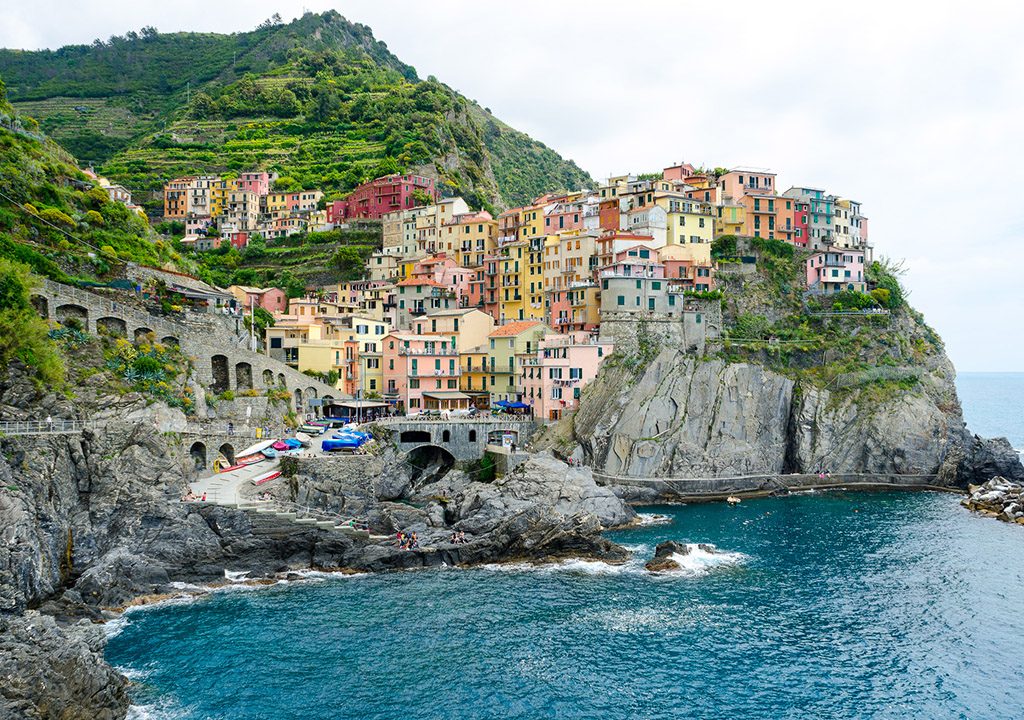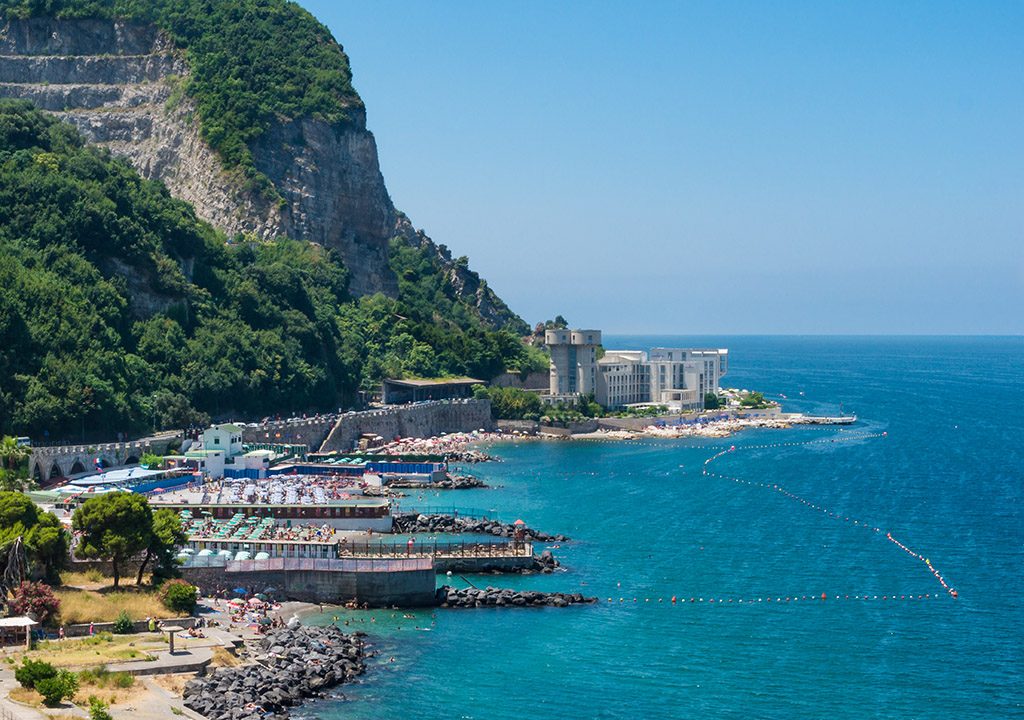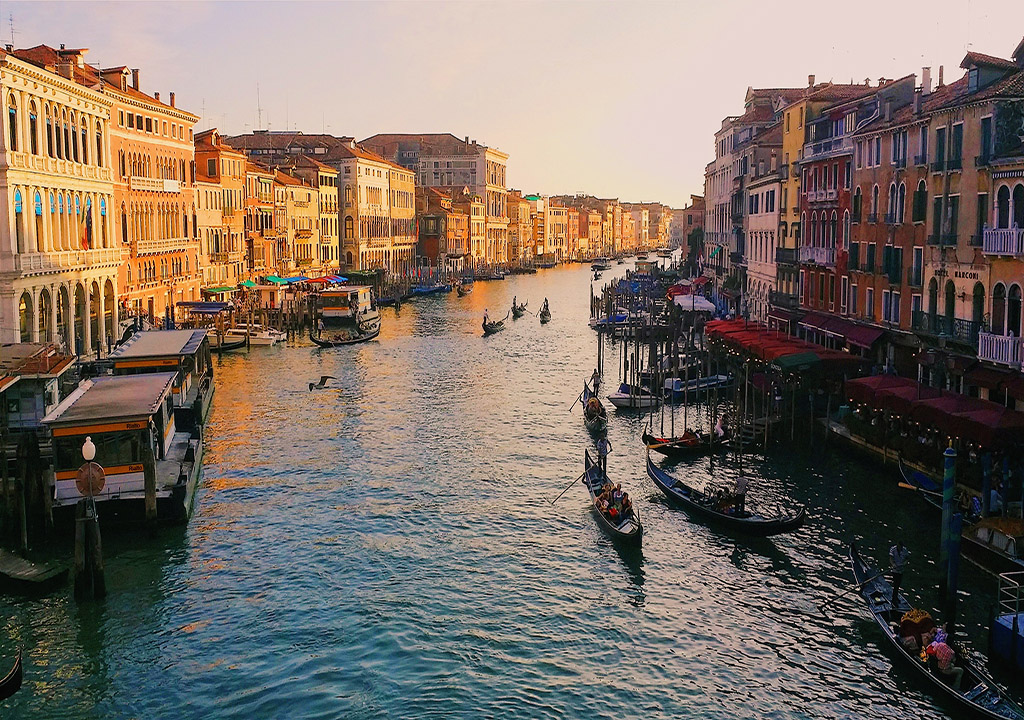Being one of the most preferred holiday destinations, Italy is praised by tourists repeatedly from all over the world. If you do not have a reason to travel, then Italy will give you many reasons to holiday and enjoy here. If you get it the way you wanted, then Italy is the country which will surprise, enchant and flatter you. People’s love for fashion, God gifted territorial shape of a “boot” makes Italy famous and one of the most recognizable countries on the world map. Art and lifestyle’s perfect blending with a modern civilization; Italy is gaining popularity since decades for its perfect balance between culture and modernity. People from different parts of the world prefer traveling to Italy for its subtle, yet an appealing beauty quite visible in its heritage structures and enviable monuments.
Italy
About The Tour
Capital: Rome
Total Area: Approx 301,338 sq kilometers (116,346 sq miles)
Time Zone: Central European Timing (GMT + 1.00); (GMT + 2.00) in summers
ISD Code:+39
Official Language:Italian
Currency: Euro (EUR)
Religion: Roman Catholicism
Climate: The climate of Italy is highly diverse. The coastal regions have mild winters and warm and generally dry summers, although lowland valleys can be quite hot in summer. Italy witnesses colder temperatures between the months of November to January. Average winter temperatures vary from 0 degrees on the Alps to 12 degrees in Sicily, like so the average summer temperatures range from 20 degrees in the Alps to over 30 degrees in Sicily.
Best Time To Travel: Italy can be best enjoyed between the months of March to October
Eat, drink and be merry’-Italians believe in living these words to their truest senses and hence, they celebrate many festivals and fairs at different times of the year to keep the spirit high. There are both national as well as regional festivals being observed in Italy and without fail all these festivals in Italy are full of fun, frolic and food.
Italy is a great place for all forms of shopping. Most cities, villages and towns, are crammed to the brim with many different forms of shops, from glitzy boutiques and huge shopping malls, to tiny art galleries, small food stores, antique dealers and general newsagents. Milan is Italy’s fashion and design capital. In the city one can find virtually every major brand in the world, not only Italian, but also French, English, American, Swedish and Spanish. Your main place for the creme de la creme shopping is the Via Montenapoleone, but the Via della Spiga, Via Manzoni, Via Sant’ Andrea and the Corso Vittorio Emanuele are equally luxurious, if not slightly less prominent, high-class shopping streets.
However, Rome and Florence, are too, serious fashion centers, and boast being the birthplace of some of the oldest fashion and jewelry houses in Italy. When in Rome, the chic and beautiful Via dei Condotti, leading to the Spanish Steps, will be your primary point of shopping reference, with boutiques but subsidary streets such as Via dei Babuino, Via Borgognona, Via Frattina, Via del Corso and the Piazza di Spagna. In Florence, via de’ Tornabuoni is the main high-fashion shopping street, and there you’ll find loads of designer brands. Jewelry and accessory shops can be found in abundance in Italy. There are loads of jewelry and accessory stores which hail from Italy. Vicenza and Valenza are considered the country’s jewelry capitals, which are also famous for their silverware and gold ware shops. Design and furniture is something Italy is proudly and justifiably famous for. Excellent quality furniture stores can be found all over, but the real place to buy the best deals is Milan. Many Italian cities have great antique furniture stores. So, one can choose between cutting-edge, avant-garde furniture, or old world antiques to buy in this country, which are, by average, of good quality.
Glassware is something which Venice makes uniquely but which is spread around the whole of the country. Here, you can get stunning goblets, crystal chandeliers, candlesticks and decorations made in stunning, multi-colored blown glass, which can be designed in modern, funky arrangements, or the classical old style. Books can be found in bookshops in every small, medium sized or big city. Art shops can be found all over in Italy, notably the most artistic cities of Florence, Rome and Venice. In Florence, the best place to go for buying art is the Oltrarno, where there are numerous ateliers selling replicas of famous paintings or similar things.
Italian food inside of Italy is different than what is served in America. It is truly one of the most diverse in the world, and in any region, or even city and village you go, there are different specialties. Italian sandwiches are quite different from the traditional Italian-American “hero”, “submarine”, or “hoagie” sandwich (which by the way means nothing to any Italian). Rather than large sandwiches with a piling of meat, vegetables, and cheese, sandwiches in Italy are often quite small, very flat, and contain a few simple ingredients with rarely, if ever, lettuce or mayonnaise. The term panini may be somewhat confusing to travelers from Northern Europe where it has erroneously come to mean a flat, heated sandwich on a grill. In Italy the term is equivalent to “bread rolls” (plural) which can be simple rolls or sometimes with basic filling. However instead of a sandwich why not try piadinas which are flat folded bread with filling, which are served warm and are typical of the coast of Emilia-Romagna.
Like the language and culture, food in Italy differs region by region. Pasta and olive oil are considered the characteristics of southern Italian food, while northern food focuses on rice and butter (although today there are many, many exceptions). The breakfast in Italy is very light, often just a cappuccino or coffee with a pastry or a piece of bread and fruit jam. Additionally, cappuccino is a breakfast drink; ordering one after lunch or dinner is considered somewhat strange and considered a typical “tourist thing”. A small espresso coffee is considered much more appropriate for digestion.
Lunch is seen as the most important part of the day, so much that Italians have one hour reserved for eating. Dinner is generally taken late. In the summer, if you are in a restaurant before 8pm you are likely to be eating on your own, and it is quite normal to see families with young children still dining after 10pm. In Italy cuisine is considered a kind of art. Italians are extremely proud of their culinary tradition and generally love food and talking about it. You should consider that Italy’s most famous dishes like pizza or spaghetti are quite common for Italians, and eating in different areas can be an interesting opportunity to taste some less well known local specialty. Even for something as simple as pizza there are significant regional variations. That of Naples has a thick, soft crust while that of Rome is considerably thinner and crustier.
Almost every city and region has its own specialties, a brief list of which may include: Risotto – Arborio rice that has been sautéed and cooked in a shallow pan with stock. The result is a very creamy and hearty dish. Arancini – Balls of rice with tomato sauce, eggs, and cheese that are deep fried. They are a southern Italian specialty, though are now quite common all over. Polenta – Yellow corn meal (yellow grits) that has been cooked with stock. It is normally served either creamy or allowed to set up and then cut into shapes and fried or roasted. Gelato is the Italian word for ice cream. The non-fruit flavors are usually made only with milk. Gelato made with water and without dairy ingredients is also known as sorbetto. It’s fresh as a sorbet, but tastier. There are many flavors, including coffee, chocolate, fruit, and tiramisu. Tiramisu Italian cake is made with coffee, mascarpone, and ladyfingers (sometimes rum) with cocoa powder on the top. The name means “pick-me-up”. Pizza is a quick and convenient meal. In most cities there are pizza shops that sell by the gram. Also, in many parts of the country pizzas have a thinner base of bread and less cheese than those found outside Italy. The most authentic, original pizzas are found in Naples – often containing quite a few ingredients. In Italy you can find nearly 800 kinds of cheese, including the famous Parmigiano Reggiano, and over 400 types of sausages.
The Colosseum of Rome – Ancient Rome’s huge amphitheater, holding up to 55000 people, was built by Emperor Vespasian. It was the scene of many deadly gladiatorial and wild animal fights. Today also the ancient remains of this structure will remind you of the daunting scenes of the past. You may see men dressed in gladiatorial costume as you walk between the Colosseum and the nearby Arch of Constantine
The Pantheon – Rome’s Pantheon, the temple of all the Gods, was built 19 centuries back by Emperor Hadrian. In the 7th century it was made into a church by early Catholics and is now lined with tombs. The Pantheon is the best preserved building of ancient Rome and today is surrounded by a pleasant and lively piazza, a nice place to sit and relax in the evening.
Roman Forum – The ancient Roman Forum is a huge complex of ruined temples, basilicas, and arches. It was the ceremonial, legal, social, and business center of ancient Rome.
The Capitoline Hill –Above the Roman Forum, the Capitoline Hill was Rome’s symbolic center and held as the Temple of Jupiter. Today there are two museums, the oldest public museums in the world, the Palazzo Nuovo, with Greek and Roman sculptures, and the Palazzo dei Conservatori, with art galleries, sculptures, and frescoes, sitting on top of this attractive hill destination.
Piazza Navona – Originally built as a stadium in the first century for athletic contests and chariot races, Piazza Navona is now lined with luxurious cafes and is the home to three lavish Baroque fountains. The ever delighting Tartufo is said to have originated here.
Saint Peter’s Square – St. Peter’s Square, the grand piazza that fronts St. Peter’s Basilica, is a significant gathering place for tourists, especially during Christmas, Easter, and church festivals. Piazza San Pietro can be reached from the long boulevard of Via della Conciliazione and from the Metropolitana on the Ottaviano “San Pietro” stop on Linea A.
The Palatine Hill – The emperors and aristocrats of ancient Rome lived on the Palatine Hill starting in the first century BC. The Domus Flavia and Domus Augustana, built in the first century AD, were the official residence of the emperors for over 300 years
The Big Buddha & Po Lin Monastery The Po Lin Monastery became significant on the world map when the beautiful Tian Tan Buddha statue (informally known as the Big Buddha) was erected in 1993. Erected 34 meters high and facing north, this majestic bronze Buddha draws pilgrims from all over the world. Opposite the statue, the Po Lin Monastery is one of Hong Kong’s most important Buddhist pilgrim spot and has been named as ‘the Buddhist World in the South’
Baths of DiocletianThe Baths of Diocletian, once covering 32 acres, were the largest public baths or thermae in ancient Rome. Although much of the original structure has been destroyed, remains of the baths are now part of the National Roman Museum. Several painted tombs have been moved and reconstructed inside the baths.
Baths of Caracalla – At the foot of the Aventine hill are the monumental ruins of the Baths of Caracalla, used from the Second to Sixth century AD. Taking a bath was a social event for the people of ancient Rome and the huge complex could hold up to 1600 bathers! Besides baths, they held an array of facilities such as a gym, art galleries, gardens, and shops selling food and drinks.
Ostia Antica The ruins of the ancient Rome port of Ostia Antica, accessible from Rome by public transportation, are well worth a visit. It is a huge complex and you can easily spend several hours wandering around the old streets, shops, and houses.
Trevi Fountain The most famous fountain in all of Italy is the Trevi Fountain, an over-the-top Baroque masterpiece completed only in 1762. At all hours of the day, the Fontana di Trevi is thronged by tourists who visit it to throw coins into its pool in the hopes that this practice will ensure a return trip to Rome. Other than the cost of a coin or two, it costs nothing to see the Trevi Fountain, making it one of Rome’s Top Free Attractions.
Bernini Fountain One of the most prolific artists in Rome was Gianlorenzo Bernini, who was active artistically from 1622-1680. In addition to breathing life into the marvelous marble creations in the Museo Borghese, Bernini sculpted several fountains in the city, the most famous of which is the Four Rivers Fountain in Piazza Navona. Other Bernini fountains appear across the city, including the Fontana del Tritone in Piazza Barberini and the Fontana della Barcaccia just below the Spanish Steps.
National Roman Museum Spread over several locations, including the Baths of Diocletian, the Palazzo Altemps, the Palazzo Massimo, and the Crypta Balbi, the National Roman Museum preserves coins, statues, sarcophagi, earthenware, frescoes, mosaics, jewelry, and other relics of Rome, from the imperial and Republican periods through medieval times. Many of the items on display were unearthed from the Roman and Imperial Flora as well as from outposts from the greater Roman Empire.
Packages
Services
Domestic
International
Cruise Ships
CONTACT US
© Copyright 2016 | Monsoon Cruise | A SkyNiche Production




